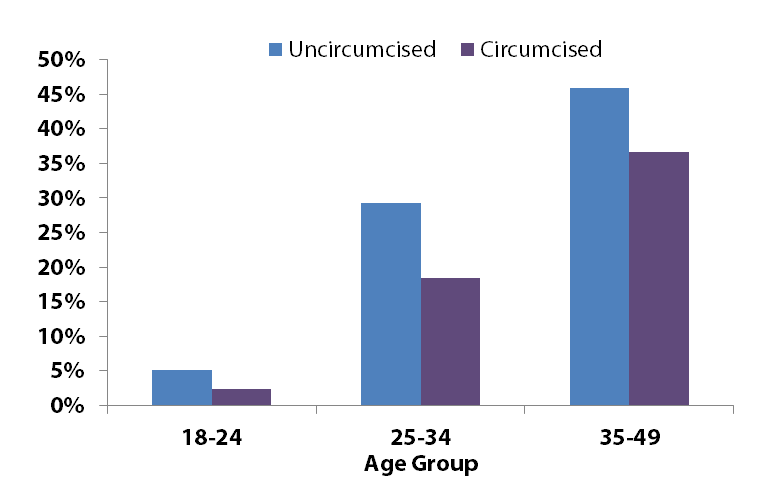Male Circumcision
A total of 10,976 men were eligible for the pre-cohort survey; 7,129 (65%) eligible men agreed to participate in the study. The mean age was 29.2 years (SE = 0.09). Seventy nine percent reported ever having had sex, and the mean age of sexual debut was 19.4 years (SE = 0.05). Ninety seven percent (97%) of surveyed men provided a self-report of circumcision status. Among them, 89% also reported a date of circumcision.
Overall, 16% of men were circumcised, according to self-report with the aid of an illustration. The mean age at time of circumcision was 20.7 years (SE=0.3). More circumcised men reported having an education higher than secondary school (25% vs. 14%). Thirty-six percent of uncircumcised men reported being unemployed compared to 24% of circumcised men.
Over two-thirds (69%) were circumcised after sexual debut. A substantial proportion (67%) reported being circumcised after the 2007 WHO recommendation for male circumcision as HIV prevention. In fact, 11% were circumcised in the six months prior to completing the pre-cohort survey at T1.
Table 1: Condom Use by Circumcision status in the past 6 months
| Always Used | Didn’t Always | p-value | ||||
|---|---|---|---|---|---|---|
| Uncircumcised | 31.3% | 63.8% | p=0.06 | |||
| Circumcised* | 35.6% | 61.2% | 61.2% | |||
| Circumcised Pre-March 2007* | 31.0% | 66.1% | p=0.03 | |||
| Circumcised Post-March 2007* | 39.6% | 57.3% | 57.3% | |||
| Circumcised Before Sexual Debut* | 32.6% | 64.7% | p=0.22 | |||
| Circumcised After Sexual Debut* | 38.2% | 59.9% | 59.9% | |||
*Does not include men circumcised < 6 months prior to time of survey
With marginal significance (p=.06), consistent condom use among circumcised men was higher (36%) than uncircumcised males (31%) [Table 1]. However, among circumcised men only, consistent condom use significantly increased after the 2007 WHO recommendation on MC for HIV prevention. Forty percent (40%) reported consistency after this recommendation compared to 31% prior to this period (p=.03). Consistent condom use did not differ between circumcised men by time of sexual debut (p=.22).
More circumcised men report prior HIV testing than uncircumcised men (78% vs. 52%, p<0.001). In total, 93 circumcised, HIV-positive men were aware of their HIV status prior to the pre-cohort survey. Among them, 61% (n=57) reported being circumcised after knowing they were HIV-positive.
Almost all circumcised men believe that circumcision confers health benefits (94%) and protects against HIV infection (85%); of note, over three-quarters (76%) of uncircumcised men also hold these beliefs. Overall, HIV prevalence was significantly higher in uncircumcised men (25%) than in circumcised men (16.4%) (p<.001) [Table 2]. Statistically significant differences in HIV prevalence by circumcision status were apparent across all age groups [Table 2].
Table 2: HIV prevalence by circumcision status
Participant Age |
Overall/All Ages | 18-24 | 25-34 | 35-49 | ||||
|---|---|---|---|---|---|---|---|---|
| Uncircumcised | 1693/6769 (25.0%) | 128/2507(5.1%) | 692/2361(29.3%) | 873/1901(45.9%) | ||||
| Circumcised* | 214/1304(16.4%) | 11.3/501.6 (2.3%) | 92.3/502.0 (18.4%) | 110/300.8 (36.6%) | ||||
| p-value | p<0.001 | p=0.011 | p<0.001 | p=0.012 | ||||

